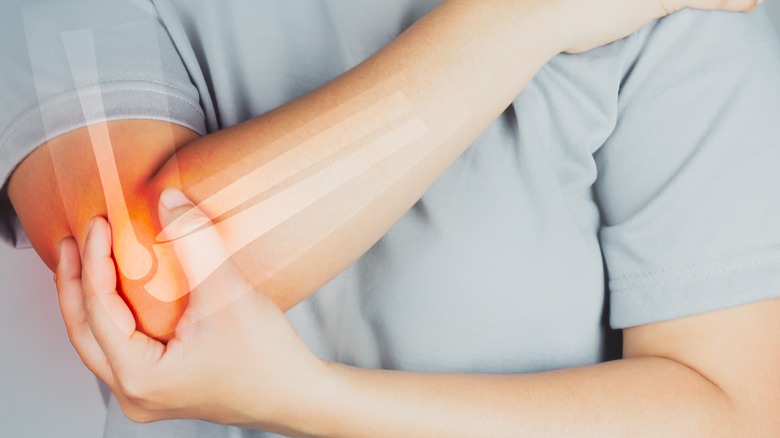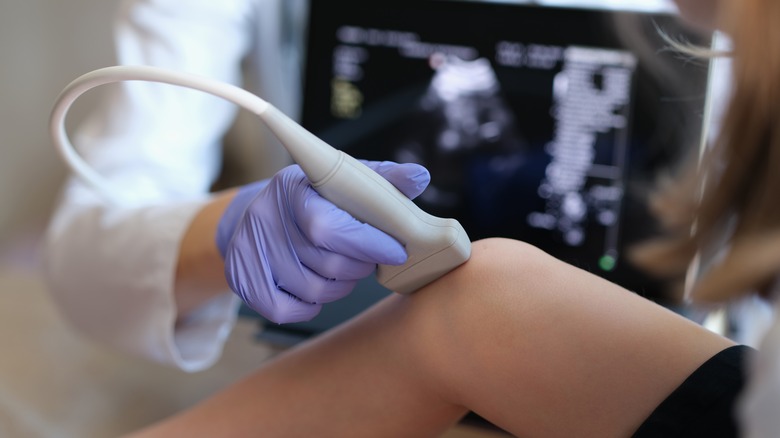Can Osteoporosis Be Related To Autoimmune Disorders?
The National Institute on Aging defines osteoporosis as a condition that weakens bones in the wrist, hip, and spine, causing them to break easily. According to the Office of Disease Prevention and Health Promotion, an estimated 10 million people aged 50 and above have osteoporosis in the United States. Over the years, osteoporosis has earned the moniker, "silent disease," because many people don't see (or rarely see) the symptoms until it's too late, per the National Institute on Aging. This is likely due to limited knowledge about bone growth.
A bone is living tissue, and the body makes new bones while eliminating tired ones, according to the Hospital for Special Surgery (HSS). Our bones begin to lose their peak mineral density after age 30, declining in bone strength and formation. This leads to an imbalance between bone formation and resorption, which increases the risk of osteoporosis, per the HSS.
Although the source lists aging as a risk factor for osteoporosis, various autoimmune problems can also make you vulnerable to the condition.
The connection between osteoporosis and autoimmune disorders
An autoimmune disorder is when the body mistakenly attacks healthy body tissues, failing to differentiate between your cells and harmful ones (via Johns Hopkins Medicine). A 2017 study published in the journal Bone Reports lists rheumatoid arthritis, inflammatory bowel disease, and systemic lupus erythematosus as well-known osteoporosis-related autoimmune diseases.
According to the Hospital for Special Surgery, people with rheumatoid arthritis have an increased risk of developing osteoporosis and are even more susceptible to osteoporosis fractures than the average population. The source further cites that chronic inflammation, and medications like prednisone and steroids, can all increase the risk of osteoporosis in a person with rheumatoid arthritis.
Apart from the connection between autoimmune diseases and osteoporosis, general causes of the condition can include low calcium intake, eating disorders, and gastrointestinal surgery side effects (via Mayo Clinic). The National Institute of Arthritis and Musculoskeletal and Skin Diseases notes that you can test your bone health by using a bone mineral density test (BMDT). If the T-score of your BMDT is -2.5 or lower, you likely have a low bone mass. Your risk of developing osteoporosis increases as the negative T-score number rises. You might want to look out for various warning signs of osteoporosis, including fragile bones, stooped posture, and loss of height, per the Mayo Clinic.
Osteoporosis risk factors & prevention
Healthline notes that osteoporosis has no cure, but various treatment options exist for managing its symptoms. It's important to speak to your doctor to understand which one is best for you. The National Institute of Arthritis and Musculoskeletal and Skin Diseases also lists several management strategies for people with autoimmune diseases, such as lupus, to prevent bone loss. They include exercising regularly and adopting calcium-rich diets, composed of 1,000mg and 1200mg of calcium daily for people above 50. Soybeans, dark green leafy vegetables, flour tortillas, soybeans, and dairy products (like milk, yogurt, and cheese) are a few calcium-rich foods you can trust to help you achieve your daily calcium intake (via WebMD).
According to UCI Health, smoking can cause some people to become prone to osteoporosis and bone fractures, making them less likely to heal effectively from musculoskeletal injuries. Medications like bisphosphonates, calcitonin, selective estrogen receptor modulators, and tissue-selective estrogen complex may also help people battling osteoporosis (per the National Institute of Arthritis and Musculoskeletal and Skin Diseases).



